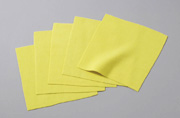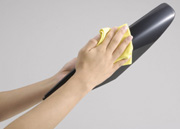News

 Example of wiping cloth use
Example of wiping cloth use
Kuraray Living Co., Ltd. (headquarters: Osaka City, President: Kiyoshi Kitagawa), a manufacturer and seller of packaging materials and miscellaneous goods and a processor and seller of nonwoven fabrics, has developed an antistatic wiping cloth with eco-friendly high-durability, in cooperation with Komatsu Seiren Co., Ltd., a major fabric dyeing and printing company. Allowing for use over a long period of time, this new wiping cloth will go on sale from February 20, 2007. Kuraray Living is applying for a patent for the new wiping cloth.
The new wiping cloth uses Kuraray's original CLACARBO thread, which is known for its carbon-containing conductive fiber. The fusion of CLACARBO's antistatic properties and Komatsu Seiren's antistatic processing capabilities has achieved a further improvement of the new cloth's antistatic properties, while enhancing the sustainability of the product's antistatic performance for a longer period.
Recently, wiping cloths made from ultra-fine thread measuring one Dtex(*) or smaller are gaining popularity for wiping off fine dust and dirt from plastic molded products, home appliances and furniture. But conventional wiping cloths generate static electricity when used, causing dust and dirt collected on once-cleaned objects. The significance of this drawback cannot be overlooked, particularly for painted or coated products. Dust and dirt on a product's surface have to be completely eliminated before final painting or coating can take place in order to prevent defective painting and coating and make the finished surface even.
The new wiping cloth suppresses static electricity generation when used, thereby preventing dust and dirt re-deposition on cleaned objects, which is caused by electrostatic charge. In addition, the antistatic performance of the wiping cloth can remain high even after it is washed a number of times. The mechanism that solves the dust and dirt re-deposition problem is as follows: (1) keeping the friction-charged electrostatic potential low and (2) reducing the "half time," which is the time required for friction-charged electrostatic potential to halve, down to one second. Thanks to this mechanism, the new wiping cloth suppresses friction-charged electrostatic potential when used for wiping objects, and the static electricity generated can be neutralized within one second. These excellent antistatic properties consequently prevent an electrostatic charge from forming on objects that are wiped with the new cloth. The high-durability also enables long-term use of the cloth, distinguishing the product as an eco-friendly wiping cloth.
The new wiping cloth can be used effectively in: (1) final wiping before painting or coating plastic molded products; (2) automobile cleaning at gas stations; (3) dust/dirt removal for automobile interiors and exteriors; (4) cleaning home appliances; and (5) cleaning and maintaining fine furniture and artwork.
- * One Dtex refers to a thread measuring 10,000 meters long and weighing one gram.
Product Overview
1. Characteristics
- (1) The new wiping cloth is a polyester fabric made from ultra-fine thread of 0.07 Dtex. A special double-cloth structure with unique ridges helps the ultra-fine thread capture and hold dust and dirt.
- (2) With a low initial friction-charged electrostatic potential of 60V and a half time of one second or shorter, static electricity generated can stay at low levels and be immediately neutralized during the use of the cloth. This suppresses electrostatic charge on objects that are wiped with the cloth, preventing re-deposition of dust and dirt after final wiping.
- (3) The friction-charged electrostatic potential is 190V, even after 20 washes, while a half time of less than one second is maintained. This demonstrates the wiping cloth's excellent antistatic performance.
- (4) The product's high-durability allows for its use over a long term, qualifying the cloth as an eco-friendly product.
| Initial | After 20 Washes | |
|---|---|---|
| New Cloth Made by Kuraray Living | 60V | 190V |
| Cloth (with Antistatic Function) by Another Maker | 6,100V | 6,500V |
- * Results based on the friction-charged electrostatic potential measurement method defined by JIS L 1094-1997, with ambient temperature of 20 degrees centigrade and relative humidity of 40%. Measurement conducted by the Japan Synthetic Textile Inspection Institute Foundation (JSTIIF).
- * Washing method defined by JIS L 0217 103 was used in the measurement.
| Initial | After 20 Washes | |
|---|---|---|
| New Cloth Made by Kuraray Living | Below 1 sec. | Below 1 sec. |
| Cloth (with Antistatic Function) by Another Maker | 5.7 sec. | 23 sec. |
- * Results based on the half time measurement method defined by JIS L 1094-1997, with ambient temperature of 20 degrees centigrade and relative humidity of 40%. Measurement conducted by JSTIIF.
- * Washing method defined by JIS L 0217 103 was used in the measurement.
2. Specifications and Price
| Product code | KS-001 |
|---|---|
| Size | 20 cm × 20 cm |
| Package | 5 sheets per bag × 10 bags = 50 sheets per box |
| Price | ¥63,000 per box (including tax) |
3. Sales Targets
| First year | ¥20 million |
|---|---|
| Second year | ¥100 million |
| Third year | ¥200 million |
Kuraray Living Co., Ltd.
| Headquarters | 1-12-39 Umeda, Kita-ku, Osaka City |
|---|---|
| Capital | ¥102 million (100% capitalized by Kuraray Co., Ltd.) |
| President | Kiyoshi Kitagawa |
| Number of employees | 37 (as of September 30, 2006) |
| Principal businesse | Design, manufacture and sale of packaging materials and miscellaneous goods; Processing and sale of nonwoven fabrics; freight agency |
